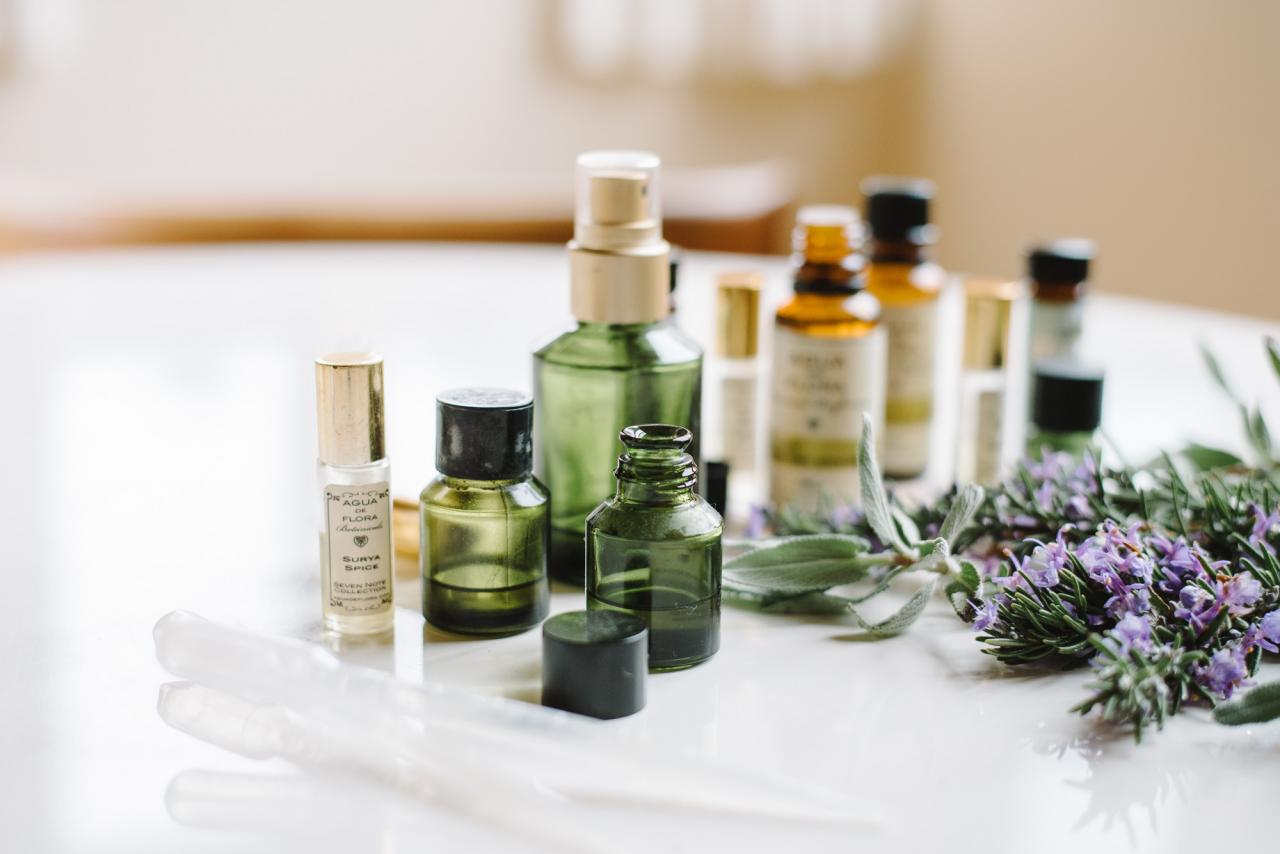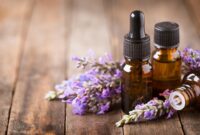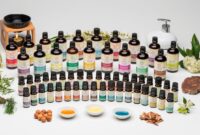How to use essential oils is a comprehensive guide for beginners that unlocks the secrets of these fragrant treasures. Essential oils have been used for centuries for their therapeutic and aromatic properties, and this guide empowers you to harness their power for a healthier, more balanced life.
This guide covers everything you need to know about essential oils, from their extraction methods to their myriad uses. Whether you’re looking to create a relaxing atmosphere, alleviate stress, or simply enjoy the natural scents of the world, this guide has something for you.
Essential Oil Overview
Essential oils are natural, volatile compounds extracted from plants. They are highly concentrated and contain the plant’s distinctive aroma and therapeutic properties.
Essential oils are composed of various chemical compounds, including terpenes, terpenoids, and phenols. These compounds give essential oils their characteristic scents and medicinal qualities.
Methods of Extracting Essential Oils
Essential oils can be extracted using several methods, each with its advantages and disadvantages:
- Steam Distillation:This is the most common method, where steam is passed through plant material to release the essential oils.
- Cold Pressing:Used for citrus fruits, this method involves pressing the fruit’s peel to extract the essential oil.
- Solvent Extraction:Involves using a solvent to dissolve the essential oils from the plant material.
- CO2 Extraction:A modern method that uses carbon dioxide to extract essential oils at low temperatures.
Essential Oil Uses: How To Use Essential Oil
Essential oils have a wide range of applications in everyday life, extending beyond their therapeutic properties. Their versatility makes them a valuable addition to any household.
Essential oils are commonly used for:
Household Uses
- Cleaning:Essential oils like lemon, eucalyptus, and tea tree possess antibacterial and antiviral properties, making them effective natural cleaning agents. They can be added to homemade cleaning solutions for a refreshing and disinfecting effect.
- Air freshening:Essential oils like lavender, peppermint, and citrus fruits can be diffused or sprayed to create a pleasant and inviting atmosphere in homes and offices.
- Pest control:Certain essential oils, such as peppermint, cinnamon, and clove, have insect-repellent properties. They can be diffused or applied topically to deter pests like mosquitoes, ants, and roaches.
Aromatherapy Uses, How to use essential oil
- Relaxation:Essential oils like lavender, chamomile, and ylang-ylang have calming and sedative effects. They can be diffused or added to baths to promote relaxation and reduce stress.
- Stress relief:Essential oils like bergamot, frankincense, and clary sage have uplifting and stress-reducing properties. They can be diffused or applied topically to alleviate tension and anxiety.
- Mood enhancement:Essential oils like citrus fruits, rosemary, and peppermint have mood-boosting effects. They can be diffused or applied topically to improve mood and enhance cognitive function.
Essential Oil Applications

Essential oils can be applied in various ways to experience their therapeutic benefits. The three primary methods of application include topical application, inhalation, and diffusion.
Topical Application
Topical application involves applying essential oils directly to the skin. This method is effective for localized pain relief, skin care, and treating specific ailments. Essential oils can be diluted in a carrier oil, such as coconut oil or jojoba oil, before applying them to the skin.
It is important to perform a patch test on a small area of skin before using essential oils topically to check for any allergic reactions.
Inhalation
Inhalation is another common method of using essential oils. Essential oils can be inhaled directly from the bottle, diffused into the air using a diffuser, or added to a hot bath or shower. Inhalation allows essential oils to enter the respiratory system, where they can have a calming or stimulating effect on the body and mind.
Diffusion
Diffusion is a method of dispersing essential oils into the air using a diffuser. Diffusers use heat or ultrasonic vibrations to create a fine mist of essential oils that can be inhaled. Diffusion is an effective way to create a relaxing or invigorating atmosphere in a room and to experience the benefits of essential oils throughout a larger space.
Safety Precautions and Potential Risks
While essential oils are generally safe for use, there are some safety precautions and potential risks to consider. Essential oils should always be diluted before applying them to the skin to avoid irritation. Some essential oils, such as peppermint oil and eucalyptus oil, can be toxic if ingested.
It is important to keep essential oils out of reach of children and pets. Pregnant women and individuals with certain medical conditions should consult with a healthcare professional before using essential oils.
Essential Oil Blending
The art of blending essential oils allows you to create personalized mixtures tailored to your specific needs and preferences. By combining different oils, you can enhance their therapeutic properties and create synergistic effects.
When blending essential oils, it’s important to consider the following factors:
Choosing Complementary Oils
- Identify the desired outcome or purpose of your blend, whether it’s relaxation, energy, or sleep.
- Research individual essential oils and their therapeutic properties to determine which ones complement each other.
- Consider the aroma and intensity of each oil and how they will blend together.
Determining Dilution Ratios
- Essential oils are highly concentrated and must be diluted before applying them to the skin.
- The recommended dilution ratio for topical application is typically 2-3% essential oil to 98-97% carrier oil (such as jojoba, almond, or coconut oil).
- For inhalation or diffusion, a lower dilution ratio of 1-2% is sufficient.
Creating Your Blend
- Measure and combine the desired essential oils in a dark glass bottle or rollerball.
- Add the carrier oil and shake well to mix thoroughly.
- Label the bottle with the blend name, ingredients, and dilution ratio.
Essential Oil Storage and Shelf Life
To maintain the potency and quality of essential oils, proper storage is essential. Essential oils should be stored in dark-colored glass bottles to protect them from light. The bottles should be kept tightly sealed to prevent evaporation and oxidation. The ideal storage temperature for essential oils is between 55°F and 75°F (13°C and 24°C).
Avoid exposing essential oils to extreme heat or cold, as this can degrade their components.
Factors Affecting Shelf Life
The shelf life of essential oils varies depending on several factors, including the type of oil, the storage conditions, and the presence of contaminants. Citrus oils, such as lemon and orange, generally have a shorter shelf life than woody oils, such as cedarwood and sandalwood.
Proper storage can extend the shelf life of essential oils significantly. Oils stored in cool, dark conditions can last for several years, while oils exposed to light and heat may degrade within a few months.
Safe Disposal
When essential oils reach the end of their shelf life or become contaminated, they should be disposed of safely. Do not pour essential oils down the drain, as this can contaminate waterways. Instead, mix the old oil with a carrier oil, such as jojoba or coconut oil, and dispose of it in the trash.
You can also soak the oil into a cotton ball or paper towel and seal it in a plastic bag before discarding it.
Essential Oil Brands and Quality

Selecting high-quality essential oils is crucial for their therapeutic benefits and overall efficacy. Reputable brands prioritize ethical sourcing, sustainable practices, and rigorous testing to ensure the purity and potency of their oils.
Industry Standards and Certifications
- ISO 9001:International standard for quality management systems, ensuring consistent production processes and product quality.
- GMP (Good Manufacturing Practices):Standards for the production, packaging, and storage of essential oils, guaranteeing their safety and quality.
- USDA Organic:Certification for oils derived from organically grown plants, free from pesticides and chemicals.
- GC-MS Analysis:Gas chromatography-mass spectrometry analysis verifies the chemical composition and purity of essential oils.
Choosing essential oil brands that adhere to these standards provides assurance of the oil’s authenticity, purity, and effectiveness.
Essential Oil Resources
In the vast world of essential oils, finding reliable and comprehensive information can be a daunting task. To assist you in your exploration, we have compiled a comprehensive list of reputable sources that cater to various aspects of essential oil knowledge, including aromatherapy, safety, and scientific research.
Books
- Essential Oil Safety: A Guide for Health Care Professionalsby Robert Tisserand and Rodney Young
- Aromatherapy for Health Professionalsby Shirley Price
- The Complete Guide to Aromatherapyby Salvatore Battaglia
Websites
These websites offer a wealth of information on essential oils, including articles, research updates, and safety guidelines:
- National Association for Holistic Aromatherapy (NAHA): https://naha.org
- Alliance of International Aromatherapists (AIA): https://www.alliance-aromatherapists.org
- Essential Oil University: https://www.essentialoils.university
Organizations
These organizations promote the safe and responsible use of essential oils through education and certification programs:
- National Association for Holistic Aromatherapy (NAHA): https://naha.org
- Alliance of International Aromatherapists (AIA): https://www.alliance-aromatherapists.org
- International Federation of Aromatherapists (IFA): https://www.ifa-aromatherapy.org
Wrap-Up
Essential oils offer a wealth of benefits, and this guide has provided you with the knowledge to use them safely and effectively. By incorporating essential oils into your daily routine, you can enhance your well-being, create a more inviting home, and connect with the natural world in a profound way.
FAQ
What are essential oils?
Essential oils are concentrated plant extracts that capture the essence of the plant’s natural aroma and therapeutic properties.
How do I use essential oils?
Essential oils can be used in a variety of ways, including inhalation, topical application, and diffusion.
What are the benefits of using essential oils?
Essential oils have a wide range of benefits, including relaxation, stress relief, mood enhancement, and improved sleep.


